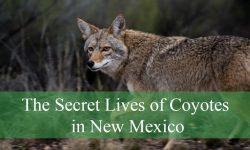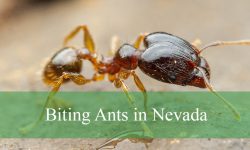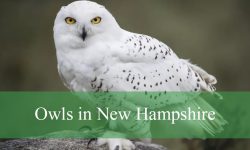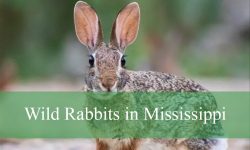If you’re passionate about birdwatching, especially the vibrant and eye-catching birds in Kansas, then this guide is perfect for you. Birds in Kansas offer an incredible variety, but there’s something truly special about the yellow birds that brighten up the skies and landscapes throughout the state. Their brilliant hues and lively behaviors make spotting them an exciting experience for any birder.
Yellow birds in Kansas come in all shapes and sizes, from the tiny, energetic American Goldfinch to the strikingly patterned Eastern Meadowlark. Each species has its own unique markings, songs, and habits that add to the colorful mosaic of Kansas’s natural beauty. Exploring prairies, woodlands, or wetlands, these birds stand out with their sunny plumage and fascinating behaviors.
This article will introduce you to 40 types of yellow birds in Kansas, complete with pictures and identification tips. If you love birds in Kansas, especially those with golden feathers, you’ll enjoy learning how to recognize these species, where to find them, and what makes each one truly unique. Get ready to add a splash of yellow to your birdwatching adventures!
Different Types of Yellow Birds in Kansas
American Goldfinch (Spinus tristis)
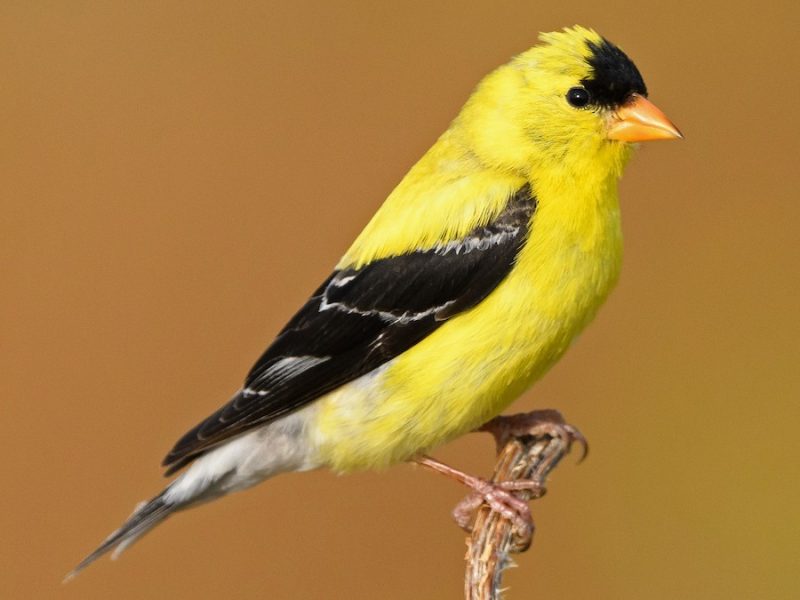
The American Goldfinch is one of the most recognizable yellow birds in Kansas, especially during the summer months. Breeding males have bright lemon-yellow bodies contrasted with black wings, a black forehead, and a white rump. Females and non-breeding males are duller, with olive-brown tones and only hints of yellow, making seasonal identification an interesting challenge for birdwatchers.
This species is known for its bounding flight pattern and cheerful, musical song that sounds like “per-chick-o-ree.” American Goldfinches are social birds, often forming flocks in open fields, weedy areas, and suburban backyards. They are late nesters, timing their breeding season to coincide with the peak of seed availability in mid-to-late summer.
In Kansas, they are found statewide, frequenting areas with thistles, sunflowers, and other seed-bearing plants. Their diet consists mostly of seeds, particularly from composites like dandelions and coneflowers. They are strict vegetarians, rarely eating insects, which is unusual for songbirds.
Eastern Meadowlark (Sturnella magna)
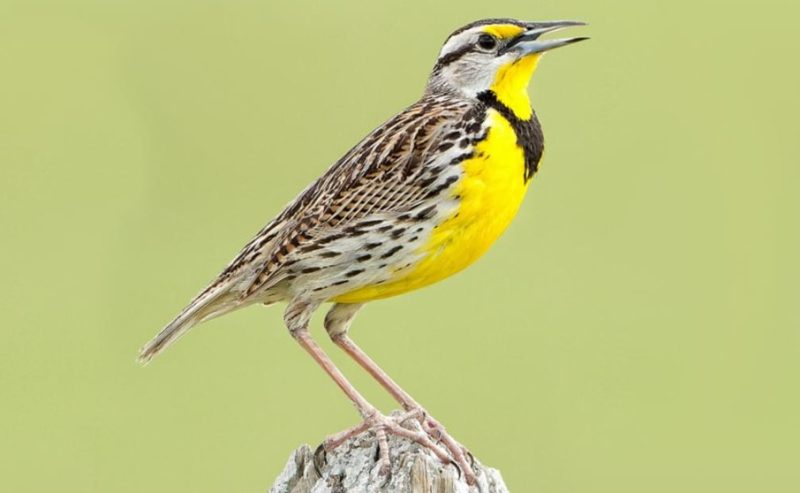
The Eastern Meadowlark is a striking bird of open grasslands and prairies, well known across Kansas for its brilliant yellow breast marked with a bold black “V.” Its upper parts are brown and streaked, helping it blend into its surroundings when seen from above. These birds are medium-sized and stocky, with a short tail and long, pointed bill.
Its flute-like song is one of the classic sounds of the Kansas prairie. Males sing from fence posts or tall grasses during the breeding season to defend their territory and attract females. They are ground nesters and may be seen performing flight displays over open fields.
Eastern Meadowlarks feed mainly on insects such as beetles, grasshoppers, and caterpillars, but also consume seeds and grains. They prefer habitats like hayfields, pastures, and natural prairie remnants. In Kansas, they are common residents throughout the year, although populations may fluctuate with habitat availability.
Western Meadowlark (Sturnella neglecta)
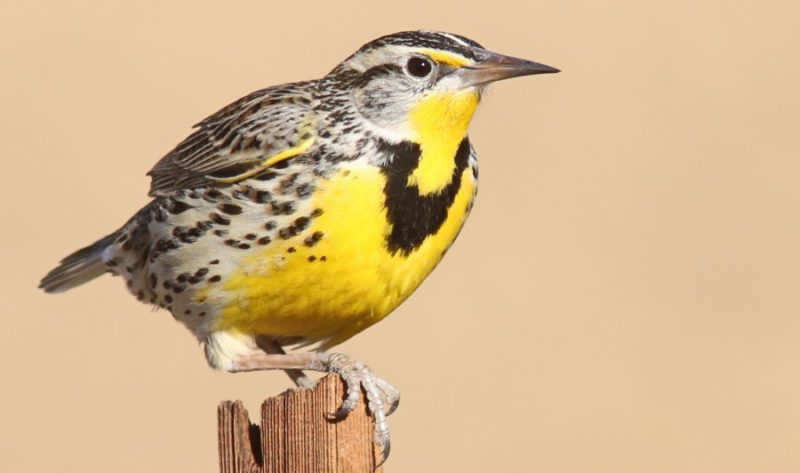
Closely related to the Eastern Meadowlark, the Western Meadowlark is similarly colored with a bright yellow belly and a black “V” on its chest. It can be distinguished by its more patterned face and the richer, flutier quality of its song. Slightly more common in western Kansas, it thrives in expansive, open areas.
This species is particularly known for its rich, melodious song, often described as a bubbling warble, which differs significantly from the simpler call of the Eastern Meadowlark. Males are highly territorial during the breeding season and often sing from elevated perches like fence posts or shrubs.
Western Meadowlarks forage mostly on the ground, searching for insects during the breeding season and shifting to seeds and grain in the fall and winter. They prefer native prairie, agricultural fields, and pastures. In Kansas, they are permanent residents and often seen during both breeding and wintering seasons.
Yellow Warbler (Setophaga petechia)
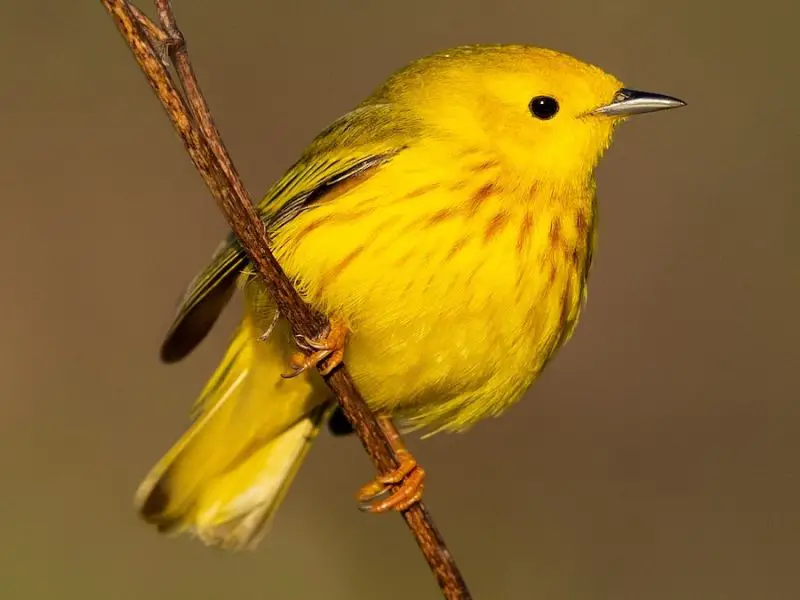
The Yellow Warbler is a small, bright yellow bird that lights up the woodlands and wetlands of Kansas during spring and summer. Males are golden yellow with faint reddish streaks on the breast, while females are paler without the streaking. Their rounded heads and medium-length tails give them a soft, approachable appearance.
Known for their sweet and cheerful song—often rendered as “sweet-sweet-sweet, I’m so sweet!”—Yellow Warblers are highly vocal and active. They are often seen flitting through willows and shrubs near water, gleaning insects from leaves and branches with their quick, agile movements.
Their diet is primarily insectivorous, including caterpillars, beetles, and flies, though they occasionally eat berries. In Kansas, they nest in dense shrubby habitats near streams, wetlands, and riparian woodlands. Their presence is seasonal, typically from April through August.
Yellow-headed Blackbird (Xanthocephalus xanthocephalus)
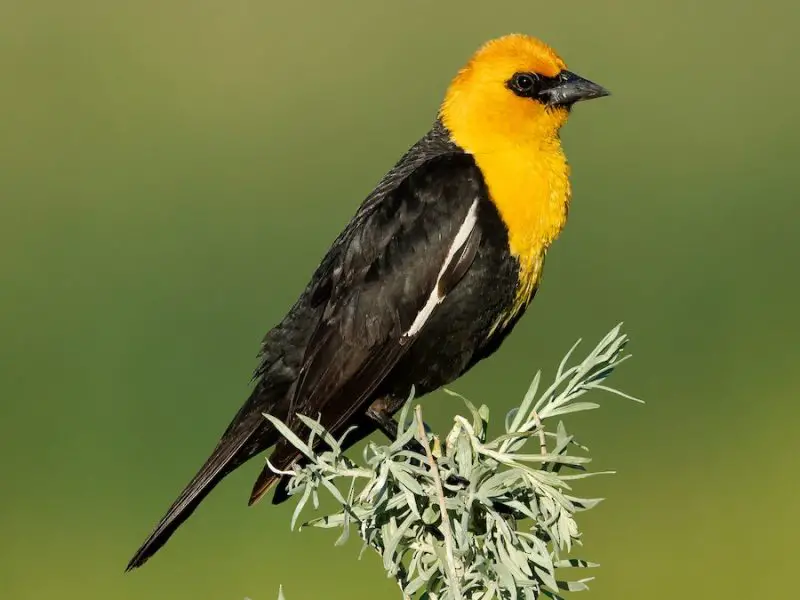
The Yellow-headed Blackbird is a striking marsh bird easily identified by its golden-yellow head and chest contrasted against a jet-black body. Males are especially eye-catching, while females are duller with mottled brown and yellow coloring. They are larger and heavier than Red-winged Blackbirds and often seen in the same habitat.
Their harsh, scraping call is one of the most unusual sounds in Kansas wetlands, often compared to a rusty farm gate. Males display from cattails or reeds, raising their heads and fanning their tails while calling. They are colonial nesters, often forming loose groups over open water or marshy edges.
In Kansas, Yellow-headed Blackbirds are primarily found in the central and western parts of the state during the breeding season. They feed on aquatic insects, seeds, and grains. After nesting, large flocks form and forage in crop fields, especially those with leftover grains and seeds.
Common Yellowthroat (Geothlypis trichas)
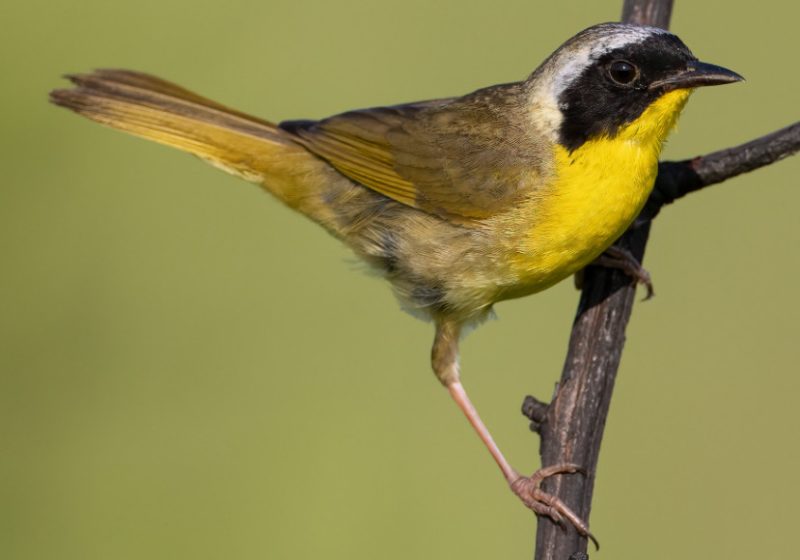
The Common Yellowthroat is a small, secretive warbler often found flitting through thick vegetation, especially around marshes, tall grasses, and wet meadows in Kansas. Males are easily recognized by their bright yellow throat and underparts, along with a bold black mask across the face bordered by a whitish line. Females lack the mask but share the same yellowish tones, making them subtler in appearance.
Their call is a distinctive, rapid “witchety-witchety-witchety,” often heard before the bird is seen. These warblers are ground-foraging and agile, darting in and out of cover while searching for insects. They tend to stay low in the foliage, especially near water sources where their camouflage offers protection.
Common Yellowthroats are widespread breeders across Kansas during the warmer months. Their diet consists primarily of insects such as beetles, spiders, and flies. Preferred habitats include cattail marshes, overgrown fields, and wetland edges—anywhere with dense vegetation for foraging and nesting.
Baltimore Oriole (Female) (Icterus galbula)
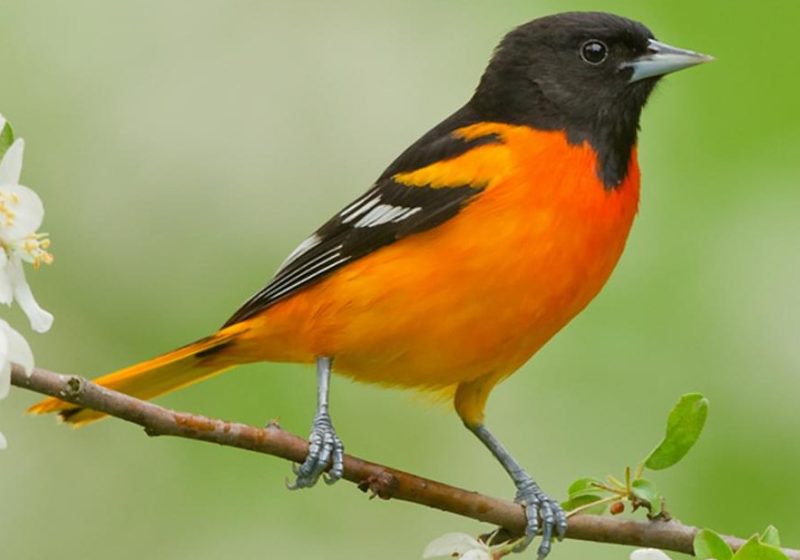
The female Baltimore Oriole is a vibrant yet softer version of the male, with yellow-orange plumage and grayish wings. Her underparts are a warm golden hue, fading to a lighter belly. Though less flashy than the male, she is still a striking presence in the woodlands and neighborhoods of Kansas during the spring and summer breeding season.
She sings a melodic, flute-like song that, while not as bold as the male’s, still contributes to the chorus of Kansas woodlands. Baltimore Orioles build intricate hanging nests from plant fibers and string, often suspended from the tips of tree branches. The nests resemble woven pouches and are engineering marvels in the bird world.
In Kansas, female Baltimore Orioles are common in deciduous trees near rivers, parks, and suburban yards. They feed on insects, fruits, and nectar. Orioles are especially fond of oranges and grape jelly, which bird enthusiasts often put out in feeders to attract them during migration and breeding.
Orchard Oriole (Female) (Icterus spurius)
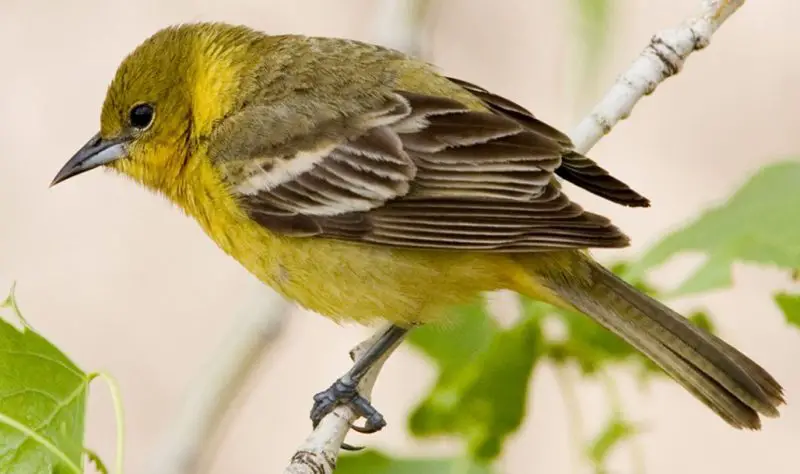
The female Orchard Oriole is a petite songbird with a rich yellow-olive body and dusky wings, more subtly colored than the males but still charming in appearance. Smaller than the Baltimore Oriole, she is delicate and quick, often seen darting among foliage in orchards and tree-lined fields during the Kansas summer.
She utters a soft, chattering call and a series of whistled notes that contribute to the early morning sounds of summer. Orchard Orioles are agile foragers, moving quickly through trees in search of caterpillars, beetles, and nectar. The females are responsible for constructing the deep cup-shaped nest, usually placed in the outer limbs of deciduous trees.
These orioles are common in Kansas from late spring through mid-summer. Their preferred habitats include orchards, open woodlands, and areas near water with scattered trees. They supplement their insect diet with small fruits and are especially active in the early morning and late evening hours.
Western Kingbird (Tyrannus verticalis)
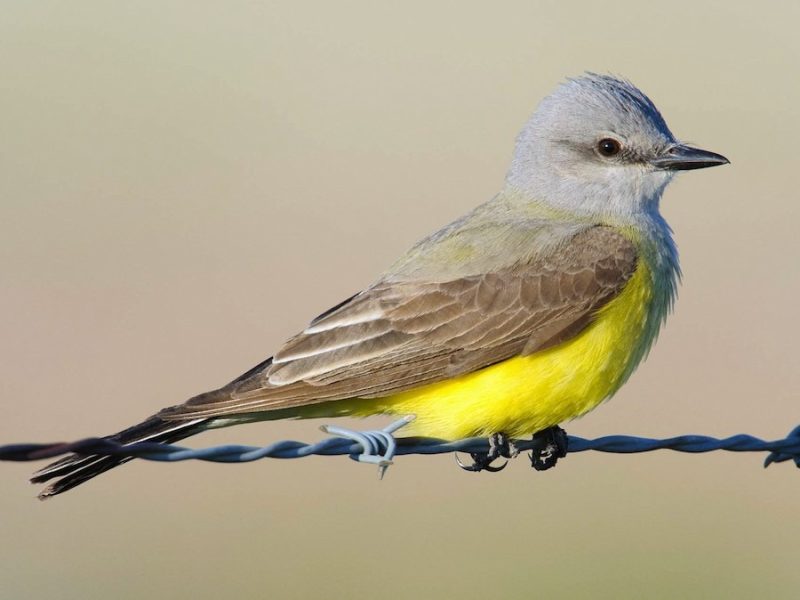
The Western Kingbird is a medium-sized flycatcher with a distinctive lemon-yellow belly, pale gray chest and head, and a black tail with white outer edges. It’s a familiar sight perched along fences and power lines throughout Kansas farmland and open country, particularly in summer.
It is known for its sharp, squeaky calls and aggressive territorial behavior. Western Kingbirds readily defend their nesting areas, even chasing off much larger birds such as hawks or crows. They often sally out from perches to catch flying insects mid-air with acrobatic precision.
This species thrives in open landscapes with scattered trees or structures for nesting, including telephone poles and utility boxes. In Kansas, they’re common breeders and are frequently observed in rural and suburban settings. Their diet mainly consists of flying insects, although they will also consume berries during the late summer months.
Dickcissel (Spiza americana)

The Dickcissel is a grassland bird that resembles a sparrow but has bright, eye-catching markings. Males display a yellow chest with a distinctive black “V” and chestnut shoulder patches, making them unmistakable during the breeding season. Females and juveniles are duller with pale streaking but still show hints of yellow.
Their song is a dry, buzzing “dick-dick-cissel,” repeated from high perches such as fence posts or tall grasses. Males sing persistently during the summer to defend their territory and attract mates. These birds are ground-nesters and form loose colonies in suitable prairie habitats.
Dickcissels are highly abundant in Kansas during the breeding season, especially in tallgrass and mixed-grass prairies. They forage on the ground for seeds and insects, particularly grasshoppers and beetles. After nesting, they often gather in large flocks and feed in grain fields and weedy margins before migrating south in the fall.
Yellow-rumped Warbler (Setophaga coronata)
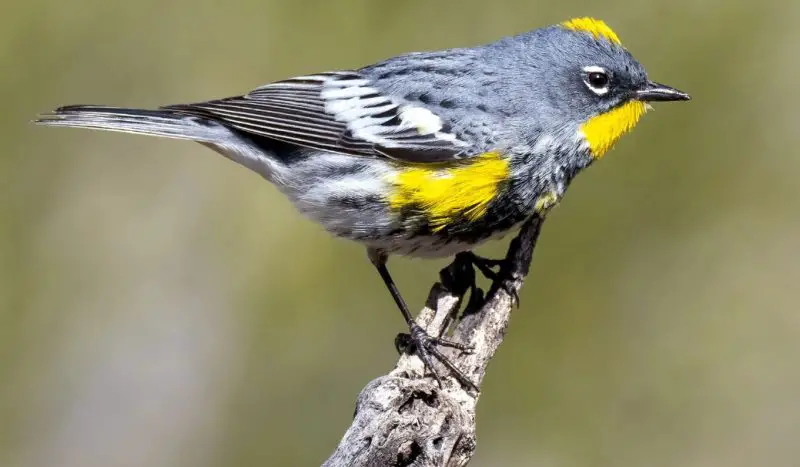
The Yellow-rumped Warbler is a small, energetic songbird easily recognized by its yellow patches on the rump, flanks, and sometimes the crown. Its body is mostly gray with white wing bars and black streaks, giving it a striking appearance. Males are more vivid than females, but both sexes share the signature yellow rump that gives the species its name.
This warbler has a sharp, trill-like song and high-pitched calls. During migration seasons—spring and fall—it can be seen flitting through trees and shrubs across Kansas, often in mixed-species flocks. It is adaptable and can be found in a variety of wooded habitats, including parks, forests, and backyards.
Unlike many other warblers, the Yellow-rumped Warbler can digest waxes found in bayberries and other fruits, allowing it to stay farther north in winter. In Kansas, they are common migrants and sometimes overwinter in mild years. Their diet includes insects, spiders, and berries, particularly during migration.
Yellow-throated Vireo (Vireo flavifrons)
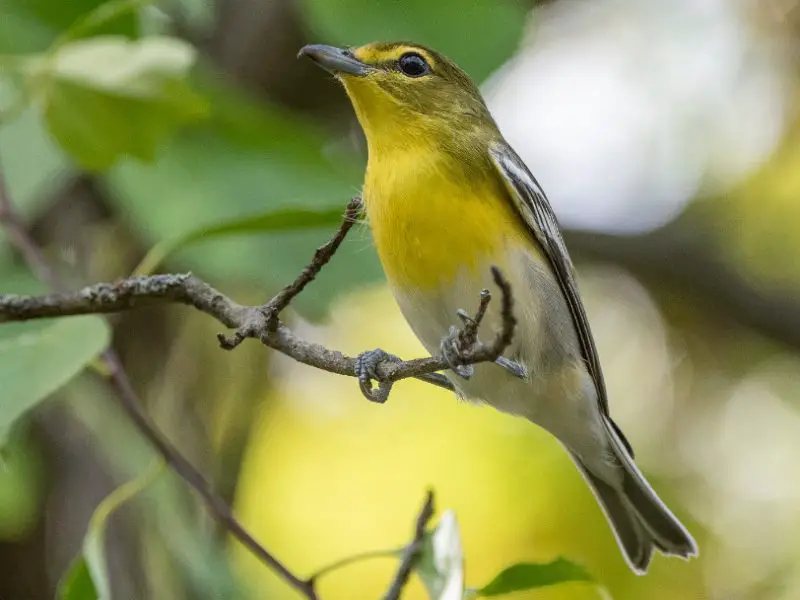
The Yellow-throated Vireo is a medium-sized vireo with a vivid yellow throat and chest, offset by an olive-green back and contrasting white belly. It also has bold white wing bars and a thick, slightly hooked bill. The combination of bright throat and gray-blue head makes it one of the most colorful vireos in Kansas.
Its song is a slow, musical series of short phrases—often described as a “three-a” or “chur-wee” call, repeated steadily from high perches. This bird prefers open woodlands and forest edges, particularly areas with mature deciduous trees. It tends to stay high in the canopy, making it more often heard than seen.
In Kansas, the Yellow-throated Vireo is a regular breeder in suitable forested habitats. It feeds mainly on insects gleaned from leaves and branches, including caterpillars, beetles, and flies. It also supplements its diet with small fruits and berries when available.
Prothonotary Warbler (Protonotaria citrea)

The Prothonotary Warbler is a brilliant golden-yellow bird with blue-gray wings and tail. Its bright plumage is especially vivid in males, who sport a glowing yellow head and breast. This species prefers wet woodland habitats, especially those near rivers, swamps, and flooded forests.
Its song is a loud, ringing “sweet-sweet-sweet-sweet,” which echoes through its watery habitats. It is a cavity-nesting warbler, often using old woodpecker holes or man-made nest boxes. Prothonotary Warblers are more secretive and less common than other yellow warblers in Kansas, but they can be found in appropriate habitats during spring and summer.
They feed primarily on insects, spiders, and snails, often foraging near the water’s edge or low in vegetation. Their presence in Kansas is mainly along wooded waterways and backwater sloughs, especially during migration or in select nesting sites.
Pine Warbler (Setophaga pinus)
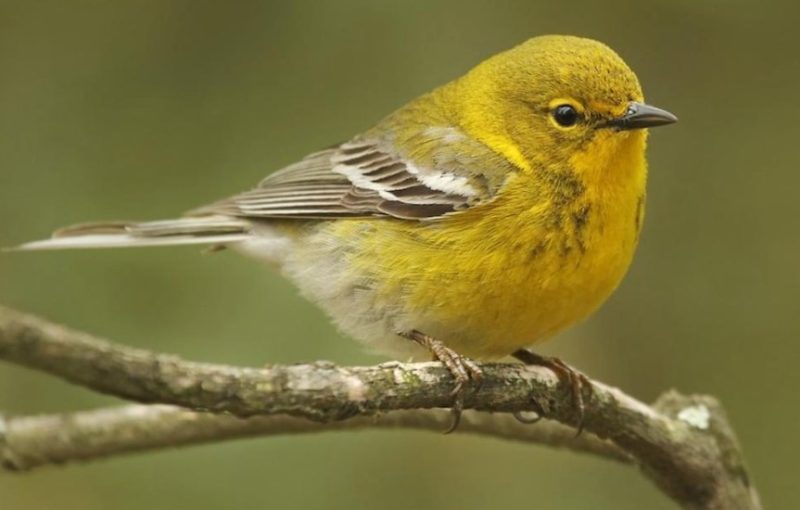
The Pine Warbler is a subtly beautiful songbird with olive-yellow coloring on the breast and face, blending into grayish upperparts and white underparts. Males are more vividly colored, while females and immatures are duller. True to its name, this warbler is closely associated with pine forests.
Its song is a musical trill, often slower and more even than that of the Chipping Sparrow. Although less common in Kansas, it may occasionally be spotted during migration or in areas with ornamental pine plantings. Its slow, methodical foraging behavior sets it apart from more frenetic warblers.
Pine Warblers eat insects, caterpillars, and spiders, but they also feed heavily on seeds—especially pine seeds—and will visit feeders for suet and sunflower seeds. Their connection to coniferous trees means sightings in Kansas are generally limited to areas with established pine groves.
Yellow-throated Warbler (Setophaga dominica)
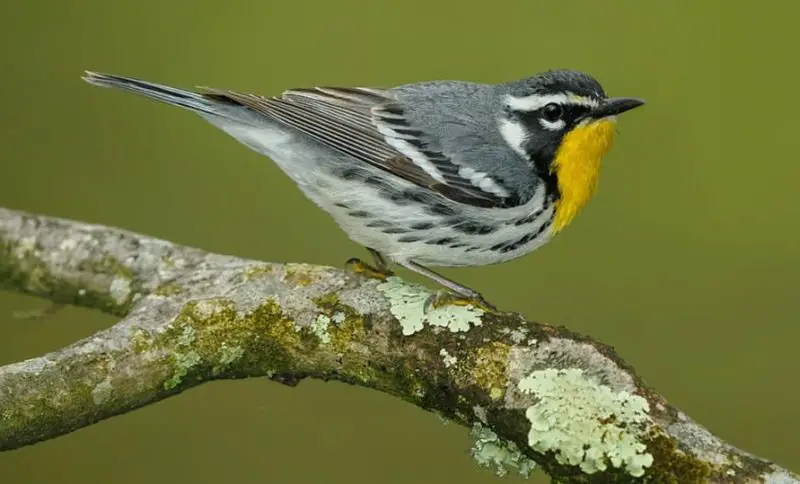
The Yellow-throated Warbler is a sleek and striking warbler with a bright yellow throat, white underparts, and a gray head marked by bold black stripes. The contrast between the white eyebrow, yellow throat, and black cheek makes it particularly eye-catching. A patch of yellow also appears on the breast.
Its song is a series of clear, descending whistles, often given from high in the canopy. Though not a common breeder in Kansas, it is sometimes seen during migration, especially in forested riparian areas or mixed woodlands. It is one of the more striking warblers encountered in the state.
The Yellow-throated Warbler feeds mainly on insects and spiders, gleaning them from bark and leaves. It prefers mature forests, especially those with tall sycamores or pines near water. Though sightings are infrequent, they are always memorable due to the bird’s bold plumage and sweet song.
Lesser Goldfinch (Spinus psaltria)
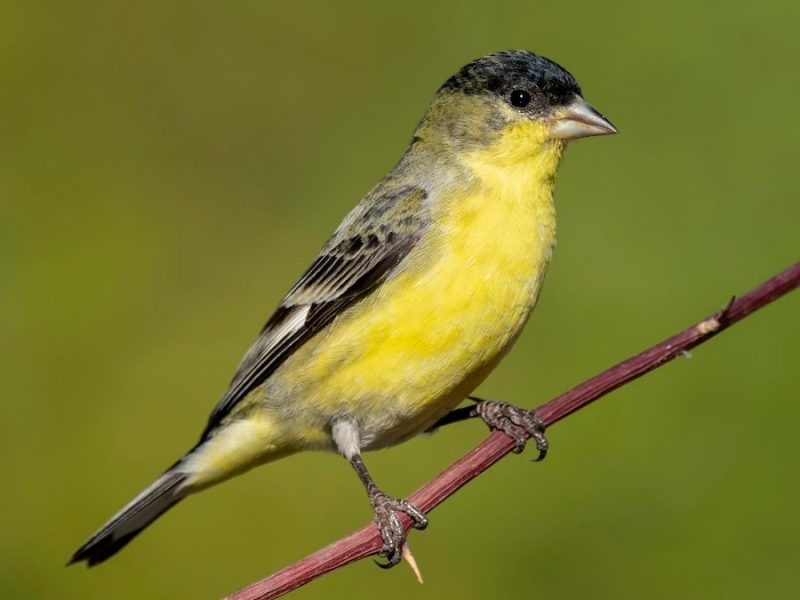
The Lesser Goldfinch is a small, agile finch with vibrant yellow underparts and a contrasting dark greenish-black back and cap. Males are especially bright, while females tend to be paler with olive backs. It is less common than the American Goldfinch in Kansas but may appear during migration or in the far southwest.
Its song is a sweet jumble of high-pitched notes and mimicked bird calls, often delivered from a perch or while fluttering in flight. Lesser Goldfinches are social and often forage in small flocks, particularly in open woodlands, scrublands, or areas with weedy vegetation.
These finches feed mostly on seeds from sunflowers, thistles, and dandelions. They will also visit feeders offering nyjer seed or sunflower chips. In Kansas, sightings are sporadic but increasing as the species gradually expands its range northward.
Evening Grosbeak (Coccothraustes vespertinus)

The Evening Grosbeak is a large, powerful finch with a massive bill and dramatic coloration. Males sport rich yellow bodies with bold black wings marked by white patches, and a striking yellow forehead. Females are more subdued, with soft gray and yellow tones.
Their call is a sharp “cheer” or “cleer,” and their presence is often revealed by flocks descending on backyard feeders during irruption years. Evening Grosbeaks are irregular winter visitors to Kansas, especially during colder years when food supplies dwindle farther north.
They feed on seeds, berries, and tree buds, often flocking to feeders for sunflower seeds. Though not resident, their winter appearances are cherished and may occur in wooded neighborhoods or forested parks across the state.
Summer Tanager (Female) (Piranga rubra)
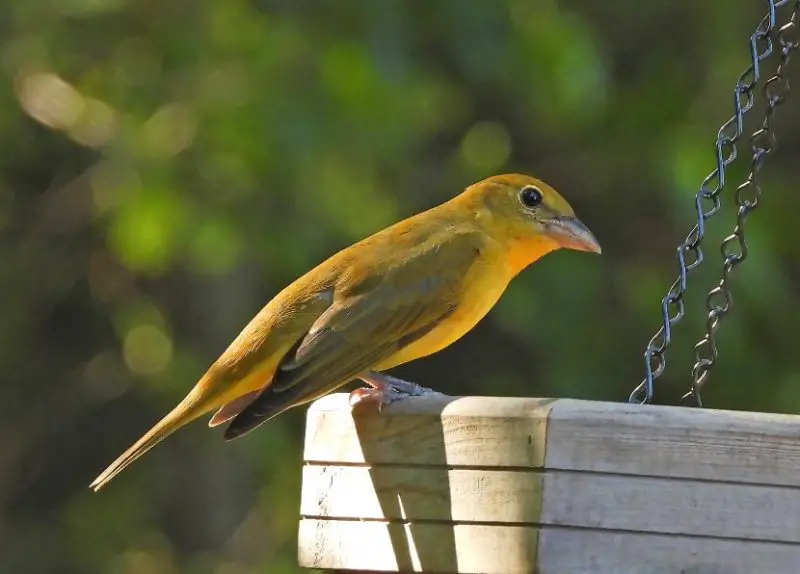
The female Summer Tanager is a beautiful bird with smooth olive-yellow plumage, subtly blending into the forest canopy. She lacks the bright red color of the male but has a warm golden wash that makes her distinct in the treetops.
Her song is a series of robin-like phrases, rich and melodic. Summer Tanagers prefer wooded areas, especially oak and pine groves, where they stay high in the canopy. In Kansas, they are summer residents mainly in the eastern and southeastern regions.
These birds feed primarily on bees and wasps, catching them in midair and removing the stingers before eating. They also consume other insects and some fruits. Spotting the female can be more difficult, but she often stays near the male during nesting season.
Painted Bunting (Female) (Passerina ciris)
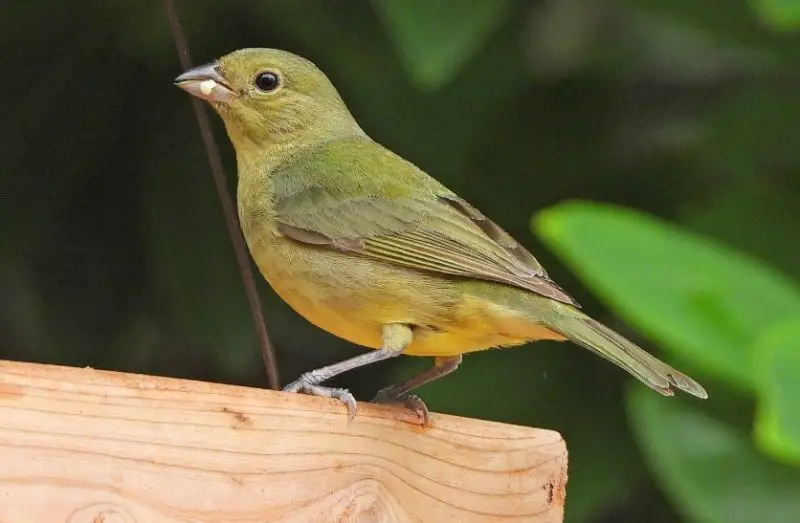
The female Painted Bunting has a soft, greenish-yellow appearance, lacking the flamboyant colors of the male but charming in her own right. Her plumage blends shades of olive, lime, and yellow, allowing her to stay hidden in thick foliage.
She has a sharp “chip” call and a subtle song that may go unnoticed. In Kansas, Painted Buntings are primarily found in the southeastern part of the state and appear more frequently in late spring and summer during breeding season.
These buntings favor brushy areas, woodland edges, and dense shrubby habitats. Their diet includes seeds, insects, and small fruits. Females build the nest and incubate the eggs, often remaining out of sight during the breeding cycle.
White-eyed Vireo (Vireo griseus)

The White-eyed Vireo is a small, active songbird with a bold personality. It features yellow flanks, a pale gray head, olive back, and bright white eyes ringed with yellow “spectacles.” This facial pattern makes it easy to identify despite its shy nature.
Its song is a quick, sharp series of phrases and clicks, often described as “pick-up-the-beer-check!” White-eyed Vireos prefer dense thickets, overgrown fields, and brushy woodland edges. In Kansas, they are uncommon but present in suitable habitats, especially in the southeast.
They forage close to the ground, searching for insects, spiders, and small fruits. Although their behavior is secretive, they are vocal and often betray their presence with constant singing from within dense vegetation.
Orange-crowned Warbler (Leiothlypis celata)
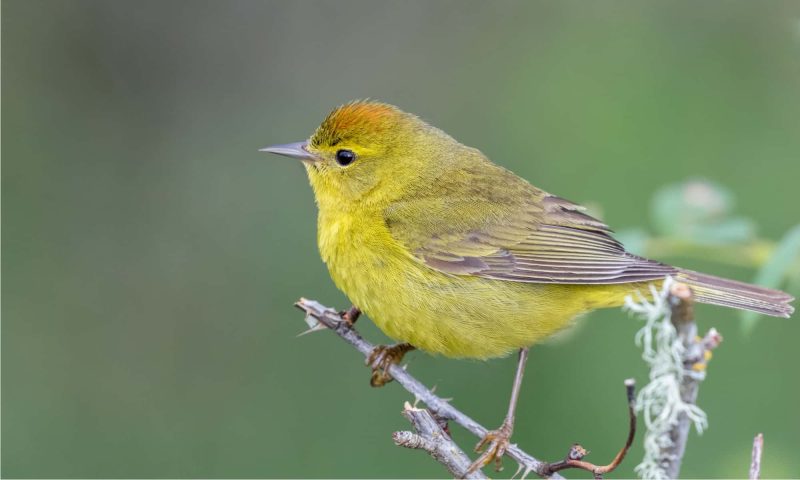
The Orange-crowned Warbler is a modestly colored bird, with dull yellowish underparts and olive-green upperparts. It has a faint eye-line and an indistinct orange crown that is often not visible. Though not as flashy as some other warblers, it is commonly seen during migration in Kansas.
Its song is a soft, trilling series of notes, often delivered from low shrubs or small trees. This species is secretive and typically forages quietly in low vegetation, searching for insects and spiders. It prefers brushy edges, woodland understories, and shrubby grasslands.
In Kansas, the Orange-crowned Warbler is a regular migrant during spring and fall. It does not breed in the state but uses the region as a stopover to rest and refuel. Its diet consists mostly of insects, though it will also eat berries and nectar when available.
Nashville Warbler (Leiothlypis ruficapilla)
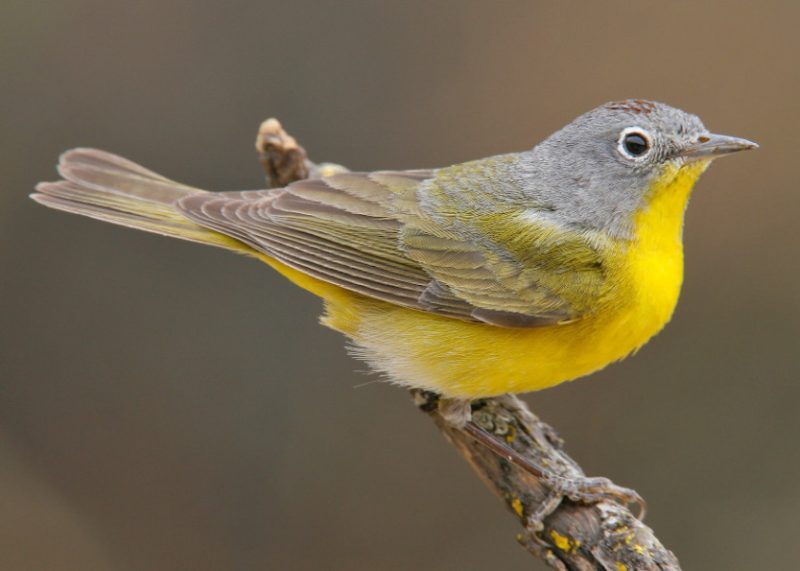
The Nashville Warbler is a small, vibrant songbird with bright yellow underparts and a contrasting gray head. It has a prominent white eye ring and a hidden reddish patch on its crown, which is seldom visible. This species is eye-catching during migration seasons.
Its song is a lively series of two-parted trills, and it also gives sharp “tsip” calls while foraging. Nashville Warblers are active and tend to flick their tails as they move through shrubs and low trees. They are commonly seen in Kansas during spring and fall migration.
This warbler prefers wooded areas, especially those with dense underbrush. It feeds mostly on insects and larvae, gleaning them from leaves and twigs. While it does not breed in Kansas, its regular appearance during migration makes it a favorite for birders.
Wilson’s Warbler (Cardellina pusilla)
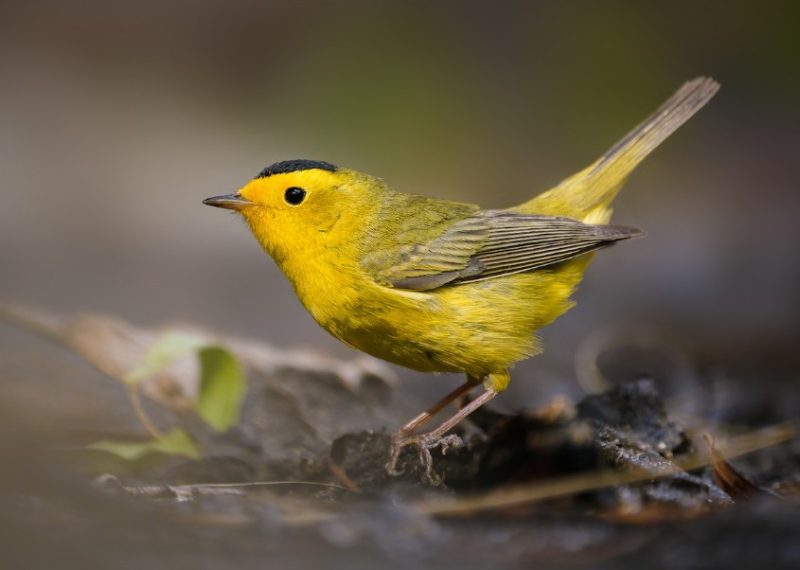
Wilson’s Warbler is a tiny, energetic warbler with a bright yellow body and a distinctive black cap, which is especially bold in males. The rest of its plumage is olive-green above, making the yellow stand out even more. It is one of the most recognizable warblers during migration.
Its song is a fast series of sharp notes that descend slightly in pitch. These birds are highly active and tend to stay low in shrubs, darting quickly through branches while searching for insects. During migration, they may visit backyard gardens and wooded edges.
In Kansas, Wilson’s Warbler is a migrant, most frequently seen in spring and fall. Its preferred habitats include moist thickets, willow patches, and riparian edges. Though small and fast-moving, its striking color and behavior make it relatively easy to spot.
Magnolia Warbler (Setophaga magnolia)
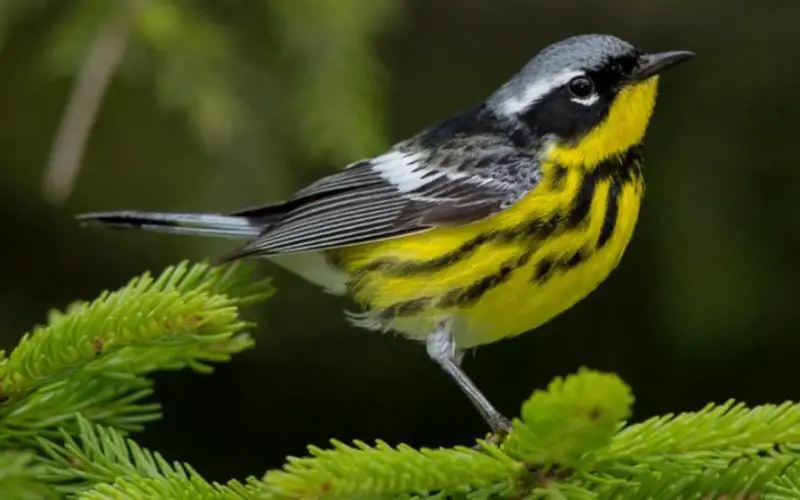
The Magnolia Warbler is a striking bird with a bright yellow breast marked by bold black streaks. Its back is gray, and the tail is black with white spots, which it fans often. Males in breeding plumage are particularly vivid, while females are slightly duller but still colorful.
It sings a sweet, whistled song during breeding season, though in Kansas it is mostly silent since it passes through only during migration. Magnolia Warblers are often found flitting through lower levels of trees, especially in forested areas and thickets.
In Kansas, this species is an uncommon migrant, primarily observed in spring and fall. It feeds mostly on insects and caterpillars, which it gleans from leaves and branches. Despite its brief presence in the state, it is a delight to spot during migration.
Palm Warbler (Setophaga palmarum)
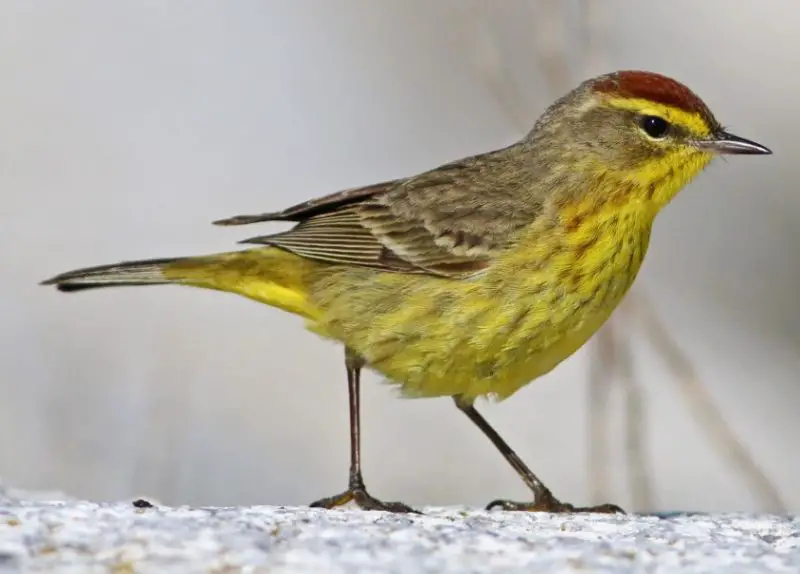
The Palm Warbler is an easily identifiable warbler thanks to its habit of constantly bobbing its tail. It has yellow undertones on the belly and under the tail, with a rusty cap that is most prominent during the breeding season. The rest of its body is brownish with streaks.
Its call is a sharp “chip,” and its song is a weak trill often heard in its northern breeding grounds. In Kansas, the Palm Warbler is mostly seen during spring and fall migrations, often in open fields, grassy patches, or weedy edges near woodlands.
It feeds primarily on insects and small arthropods but will also take seeds and berries. Though not a breeder in Kansas, the Palm Warbler is a familiar and welcome migrant whose wagging tail and subtle beauty draw attention during its brief visits.
Black-throated Green Warbler (Setophaga virens)
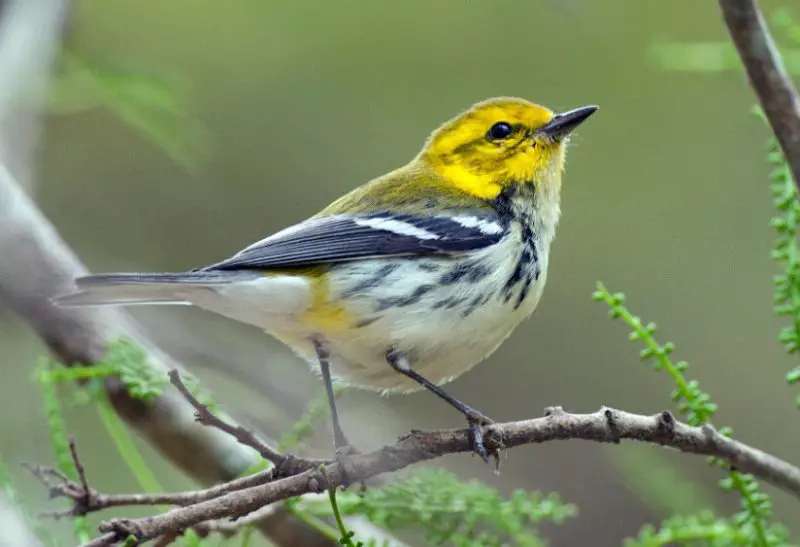
The Black-throated Green Warbler is a striking songbird with a pale yellow face and underparts, contrasted by a bold black throat in males. Its back is olive green, and it has dark wings with two white wing bars. Females and immatures are duller but retain the yellow facial features.
Its song is a buzzy series of notes often rendered as “zee-zee-zee-zoo-zee,” making it easier to locate during spring migration. This species forages actively among the branches, searching for insects and spiders in mid to upper canopy levels. It is quick and agile, often flitting between twigs.
In Kansas, the Black-throated Green Warbler is an uncommon migrant, most likely seen during spring and fall. It favors forested areas, especially mature deciduous and mixed woodlands. Although rare, birders may encounter it in dense forest edges or woodland preserves.
Scarlet Tanager (Female) (Piranga olivacea)
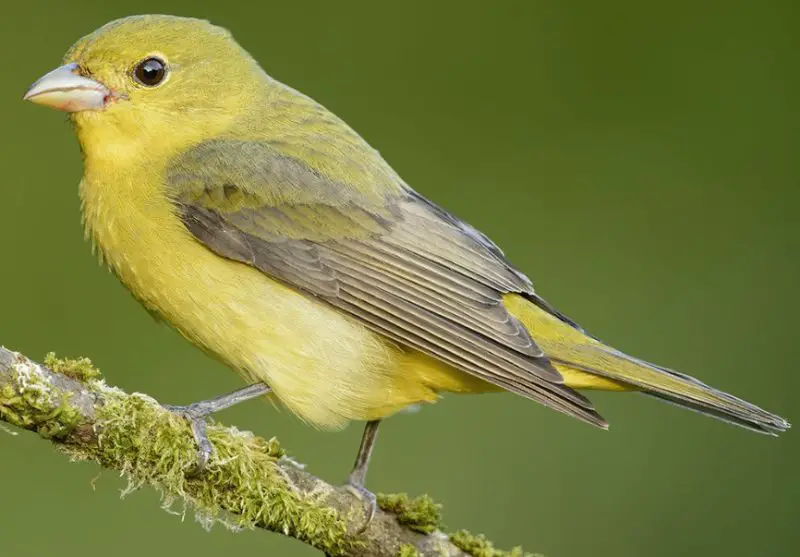
The female Scarlet Tanager has an olive-yellow body with darker olive-green wings and tail. Unlike the brilliant red male, the female’s plumage is subtler, helping her blend into the forest canopy. She has a thick, slightly curved bill adapted for fruit and insect consumption.
Her song is a husky, robin-like series of notes, while her call is a distinctive “chip-churr.” Female Scarlet Tanagers tend to stay hidden in treetops, where they quietly forage for insects, fruits, and berries. They are known for their stealthy, deliberate movements.
In Kansas, the female Scarlet Tanager is a rare visitor, mostly during migration seasons. She inhabits mature forests and well-wooded parks, preferring high canopy areas. Though elusive, careful observation may reveal her graceful presence during spring or fall.
Canada Warbler (Cardellina canadensis)
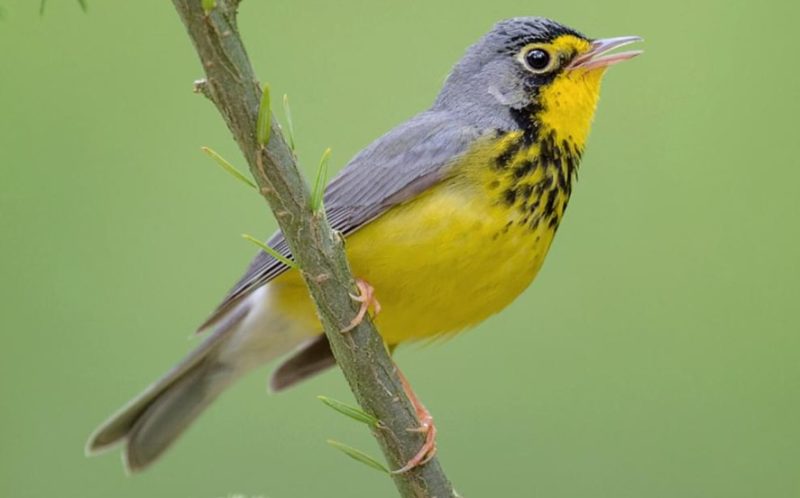
The Canada Warbler is a small, elegant bird known for its vibrant yellow underparts and slate-gray back. Its most recognizable feature is the bold black “necklace” of streaks across its chest, more defined in males. It also has a bright yellow face with a white eye-ring.
Its song is a fast, musical warble that often includes sharp chips. Canada Warblers are energetic and active foragers, typically staying low in dense undergrowth. They flit rapidly between branches, scanning for insects and other small invertebrates.
This species is a transient visitor in Kansas, passing through during spring and fall migration. It prefers moist woodlands, riparian zones, and thickets, especially areas with rich understory vegetation. Despite its brief visits, its distinct look makes it a favorite among birders.
Blue-winged Warbler (Vermivora cyanoptera)

The Blue-winged Warbler is a brightly colored songbird with lemon-yellow plumage across the body and contrasting bluish-gray wings. A thin black eye-line gives it a sharp, defined look. Males and females appear similar, though males may be slightly brighter.
Its song is a buzzy “bee-buzz,” and it often gives sharp “tsik” calls while foraging. This warbler spends much of its time in dense brush, young forests, and shrubby clearings, where it gleans caterpillars and insects from foliage.
In Kansas, the Blue-winged Warbler is an uncommon and local visitor, mainly during spring migration. It favors early successional habitats and forest edges, particularly areas with dense underbrush. While not widespread, it may be spotted in suitable habitats during migration.
Western Tanager (Female) (Piranga ludoviciana)

The female Western Tanager has a soft yellow belly, grayish back, and olive tones throughout her plumage. Her subtle coloring helps her blend into wooded environments, unlike the vivid red-and-yellow males. She has a sturdy bill suited for consuming both insects and fruit.
Her call is a dry “pit-er-ick” and her song is a series of short, robin-like phrases. Females are often quiet and stay high in the canopy, moving deliberately through the branches in search of food. They are less conspicuous than males but equally graceful.
In Kansas, female Western Tanagers are rare migrants, generally passing through during spring. They are most likely seen in mixed woodlands and conifer groves, especially during cool weather fronts. Observers lucky enough to spot them often catch a glimpse during brief stopovers.
Cape May Warbler (Setophaga tigrina)
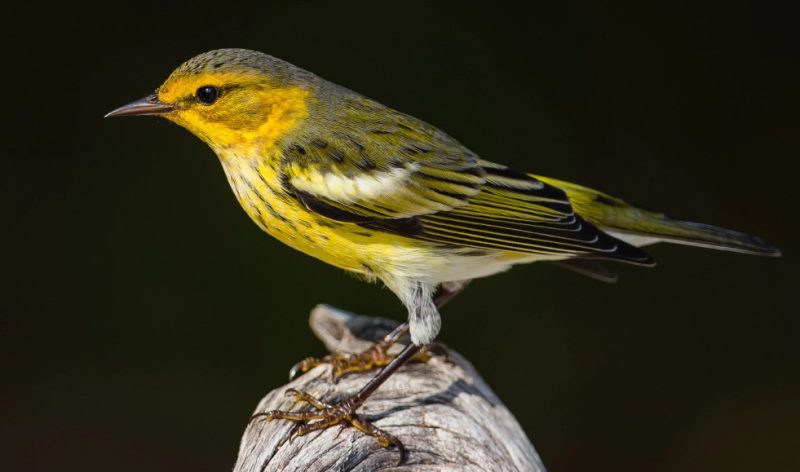
The Cape May Warbler is a small, brightly colored warbler with rich yellow underparts and bold black streaks running down the chest and sides. Males have a chestnut patch on the cheek, bordered by black, while females are paler with similar streaking. A thin white wing patch adds to their distinctive look.
Its song is a high-pitched, lispy series of notes, often hard to hear from a distance. This species is an active forager, frequently seen hopping through treetops where it gleans insects from foliage. It has a unique curved tongue that helps it feed on nectar and honeydew.
Though not common in Kansas, the Cape May Warbler can be spotted during spring and fall migration. It typically favors coniferous and mixed forests during its breeding season, but during migration it can be found in wooded parks, gardens, and edges of woodlands.
Hooded Warbler (Setophaga citrina)

The Hooded Warbler is a stunning forest bird with vibrant yellow underparts and a bold black hood and throat in males. Females lack the complete black hood but retain the bright yellow face and body. Both sexes have large black eyes that give them a striking expression.
Its song is a clear, whistled “ta-wit ta-wit ta-wit tee-yo,” often heard in dense understory. Hooded Warblers prefer shady, moist forests where they forage low in shrubs and tangles. They move quickly and often remain hidden within the foliage.
In Kansas, the Hooded Warbler is considered rare and mostly seen during migration. When it does appear, it is usually in dense woodlands or riparian corridors with thick vegetation. Birders need patience and sharp ears to locate this elusive and striking warbler.
Prairie Warbler (Setophaga discolor)
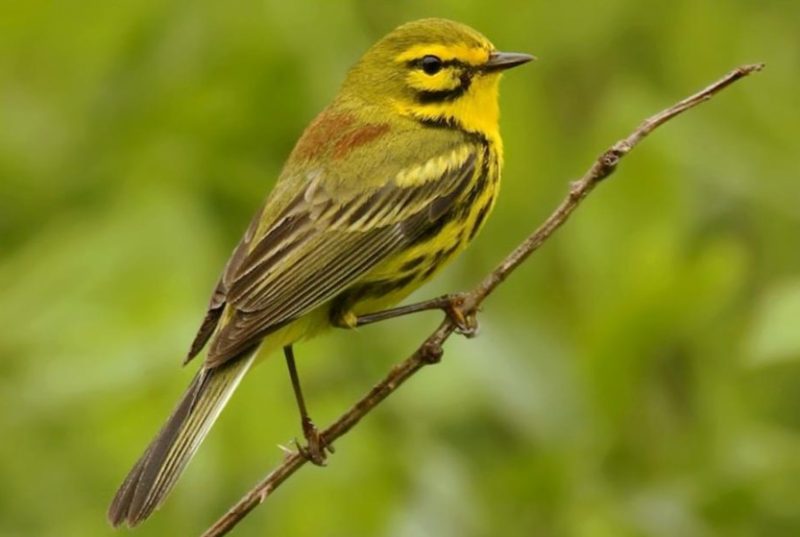
The Prairie Warbler features a bright yellow chest with distinctive black streaks on its sides. It has an olive-green back and a thin black eye line that adds to its sharp facial appearance. Despite the name, it prefers shrubby fields and regenerating forests more than open prairies.
Its song is a rising, buzzy “zee-zee-zee-zee” that’s easily recognizable during breeding season. Prairie Warblers are highly active and often perch in exposed shrubs, bobbing their tails as they forage. They mostly feed on small insects and spiders.
In Kansas, the distribution of Prairie Warblers is patchy and localized. They are not widespread and are more likely to be found in suitable early-successional habitats or along forest edges. Their presence is often tied to specific habitat conditions.
Cedar Waxwing (Bombycilla cedrorum)

The Cedar Waxwing is a sleek, elegant bird with a soft brown head and chest that fades to pale yellow on the belly. While not a fully yellow bird, its tail has a bright yellow tip, and some individuals show a buttery wash on the lower belly. It also features a black mask and red waxy tips on the wing feathers.
Its high-pitched calls resemble thin whistles, and it’s often heard before being seen. Cedar Waxwings are sociable, usually found in flocks, and they have a fondness for fruit. In summer, they feed on berries and insects, while in winter, fruit makes up most of their diet.
Cedar Waxwings are common in Kansas year-round. They frequent woodlands, orchards, parks, and urban areas, especially where fruiting trees and shrubs are abundant. Their graceful flight and flocking behavior make them a favorite among birdwatchers.
American Redstart (Female) (Setophaga ruticilla)

The female American Redstart has gray-olive upperparts with yellow patches on the wings, flanks, and tail. Though not entirely yellow, these flashes of color are striking when the bird fans its tail. She is smaller and more muted than the male, which is black and orange.
She sings less often than males but gives sharp “chip” notes and engages in fluttery, fanned-tail displays to flush insects from leaves. Active and energetic, female redstarts are constantly moving through trees and shrubs as they forage.
In Kansas, American Redstarts are fairly common migrants and sometimes breed in the eastern part of the state. They are typically found in deciduous forests, riparian woodlands, and shrubby edges. Their animated behavior and tail-flicking habits make them easily recognizable.

